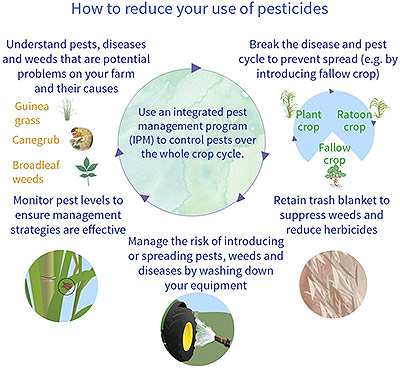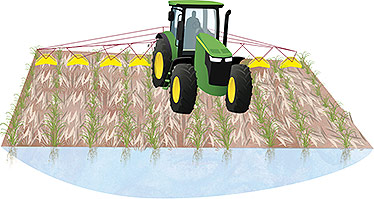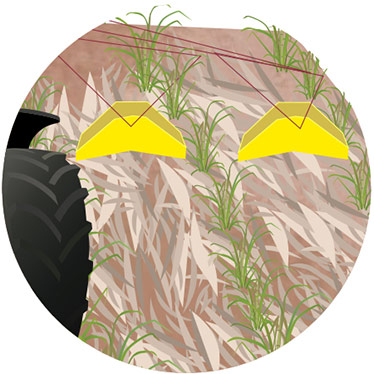Sugarcane support programs
Across industry, and the Queensland and Australian governments, there are a number of programs and support tools that help sugarcane farmers adopt improved farming practices. The Queensland Government is also continuing to invest in science projects that improve our understanding of the issues facing the Reef and develop tools to support sugarcane farmers to undertake the most appropriate management practices to suit their specific conditions.
- Support programs for sugarcane farmers
- Support tools for sugarcane farmers
- Reducing nutrient run-off
- Reducing pesticide run-off
More information is available at land management for sugarcane farmers.
Support programs for sugarcane farmers
The Smartcane Best Management Practice (BMP) program is an industry developed, robust and practical system that is about improving productivity, profitability and sustainability of farm enterprises. Through the Smartcane BMP, growers self-assess their practices to determine if they are ‘below’, ‘at’, or ‘above’ the industry standard. If their activities are below the industry standard, the system shows what they would need to do to reach that standard. Help is also available through local facilitators, who can also assist growers to have their farms independently BMP accredited.
Meeting the Smartcane BMP ‘industry standard’ in the following modules will also help growers meet the regulated standards. These will most likely save you money, while assisting in minimising the risk of nutrients, pesticides and sediment leaving the property and impacts on the health of the Reef.
- Soil Health and Nutrient Management
- Irrigation and Drainage Management
- Weed, Pest and Disease Management
For more information or to register for Smartcane BMP, please contact the CANEGROWERS BMP Project Manager, Kate Gowdie on 0447 035 840 or email kate_gowdie@canegrowers.com.au.
For information on the benefits of being involved, read the recognised programs and acknowledged projects page.
The SIX EASY STEPS™ program, developed by Sugar Research Australia, is a grower-friendly nutrient management program, used to improve nutrient management, The SIX EASY STEPS™ (PDF, 148KB).
To find out more about the The SIX EASY STEPS™ approach or who might be able to assist you locally, please contact Sugar Research Australia.
Local cane productivity services provide extension and research into Queensland's sugar cane industry. District productivity services provide advice to sugar cane farmers on pests, diseases, herbicides, fertilisers, and how to enhance the profitability and productivity of your farm.
Regional Natural Resource Management bodies, such as Terrain, NQ Dry Tropics and Reef Catchments frequently run programs to assist farmers and graziers to improve their land and water health.
Reef Trust is an Australian Government initiative that provides innovative and targeted investment focused on improving water quality, restoring coastal ecosystem health and enhancing species protection in the Great Barrier Reef region.
Phase 4 Trialling of enhanced efficiency fertilisers has co-invested funds to support the broader trialling of enhanced efficiency fertilisers and accelerate the evaluation of the technology as a strategy to reduce the loss of nitrogen to the Reef.
Phase 4 Repeated tenders will engage farmers in the Wet Tropics and Burdekin natural resource management regions to improve their nitrogen fertiliser and farm management practices to reduce pollutant run off into the Reef lagoon.
Phase 5 Supporting cane farmers to move beyond industry best practice is an investment by the sugarcane industry and the Australian Government to improve on-farm nutrient management and improve the quality of water entering the Reef.
The Water Quality Grants and Partnership component of the Australian Government Reef Programme aims to increase the voluntary uptake of improved land management practices by landholders that will reduce the discharge of sediments, nutrients and pesticides into the Great Barrier Reef lagoon. Please contact your local Natural Resource Management organisation for further information on participating in this Programme.
Reef Alliance is a partnership between industry and NRM bodies who work closely with communities, private business and government to deliver farm specific and whole of landscape projects in reef catchments. Visit the Reef Alliance website to find out about the projects you could access through Reef Alliance.
Extension services
The Department of Agriculture and Fisheries offers a range of extension services to support sugarcane growers to adopt better business and farming practices.
Support tools for sugarcane farmers
NutriCalc™ is an online nutrient management tool and part of Sugar Research Australia’s Six Easy Steps™ nutrient management package. Jointly developed with the National Centre for Engineering in Agriculture (NCEA) this tool can help growers develop nutrient management plans for use on-farm.
The Farm Economic Analysis Tool (FEAT) is a planning and decision-making tool developed to assist cane farming enterprises. FEAT gauges the economic impact of changing from one farming system to another.
FertFinder is a new online tool developed by Sugar Research Australia to help cane farmers and advisors select the right fertiliser blend in their region to match the nutritional requirements in their paddock. It also helps filter through the hundreds of fertiliser products available on the market.
Controls on chemical use provided by DAF, is also a useful guideline for safe use of agricultural and veterinary chemicals.
Reducing nutrient run-off
Adopting practices for effective nutrient management can improve farm productivity and profitability and reduce losses to the Reef.
Matching nitrogen applications to crop requirements also reduces nitrogen losses. Nutrients from sources such as legumes and mill mud may substantially increase nutrient surpluses and thus have water quality impacts. Using the SIX EASY STEPS™ methodology will help you calculate how much fertiliser to apply including all sources of nutrients.
SIX EASY STEPS™
- Know and understand your soils.
- Understand and manage nutrient processes and losses.
- Regular soil testing.
- Adopt soil-specific nutrient management guidelines.
- Check on the adequacy of nutrient inputs (e.g leaf analyses).
- Monitor and keep good records to modify nutrient inputs when and where necessary.
In a furrow irrigation setting, mill mud applied directly to cane rows, rather than being broadcast or applied to the inter-row, can reduce the amount of nutrients lost (see Figure 1).


In furrow irrigated sugarcane, increasing irrigation efficiency (i.e. reducing over-application of irrigation) also reduces nutrient losses. Efficiencies can be increased by better managing irrigation to crop demand or moving from systems with lower to higher efficiency (e.g. moving from furrow to drip irrigation) (see Figure 2).


How to optimise irrigation on your farm
- Use tools (e.g. soil moisture probes, automation and irrigation software) that can help schedule and apply the right amount of irrigation water to match the water holding capacity of the soil.
- Drip irrigation or overhead irrigation may have better water use efficiency than furrow irrigation. If you are using a furrow system, consider the shape and length of the furrow for your soil types to minimise deep drainage and run-off.
- Recycle pits should be located on suitable soil types and have sufficient free storage to capture run-off.
Reducing pesticide run-off
In addition to following the label instructions for pesticides, the most effective way to reduce pesticide losses is to adopt practices for effective pesticide management (see Figure 3).
How to reduce your use of pesticides
- Use an integrated pest management program (IPM) to control pests over the whole crop cycle
- Break the disease and pest cycle to prevent spread (e.g. by introducing fallow crop)
- Retain trash blanket to suppress weeds and reduce herbicides
- Manage the risk of introducing or spreading pests, weeds and diseases by washing down your equipment
- Monitor pest levels to ensure management strategies are effective
- Understand pests, diseases and weeds that are potential problems on your farm and their causes


Effective practices include better managing pesticide application timing (i.e. increasing the time between application and significant rainfall events or irrigation), placement and application method (e.g. banded spraying) (see Figure 4 and 5).



A banded sprayer (PDF, 705KB) allows growers to spray herbicides to strategically target weeds, reduce the use of residual herbicides and decrease costs.
How to apply herbicides effectively
- Monitor weed populations to apply herbicide during early growth.
- Read the label of the chemical to determine the correct rates, timing or other restrictions. These are usually under ‘general instructions’ or ‘critical comments’ section of the label.
- Consider whether residual herbicides are necessary or if knockdown products could achieve the same result.
- Calibrate the spray rig regularly. Monitor the pressure gauge and check for leaks.
- Band spray herbicides using hooded or directed spraying equipment to reduce the use of residuals.
In addition, you should consider taking part in the voluntary Smartcane BMP. This industry developed program is a robust and practical system that is about improving productivity, profitability and sustainability of farm enterprises. Does joining the Smartcane BMP pay off? Read grower case studies to hear their stories.


